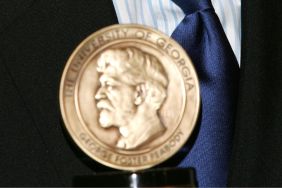It’s impossible to talk about the relatively small world of women filmmakers without mentioning Mira Nair, the mother of the Indo-American film movement who successfully traversed the line of popular mainstream filmmaking and storytelling while staying true to her Indian roots.
After adapting the literary classic Vanity Fair for Reese Witherspoon, Nair has returned to those roots, reteaming with writing partner Sooni Taraporevala for the first time since their 1991 film “Mississippi Masala” for an adaptation of Jhumpa Lahiri’s bestselling novel The Namesake. It stars Kal Penn as the poorly named Gogol Ganguli, the son of Indian immigrants who tries to make his way of life separate from his heritage, only to have to embrace his roots after a family tragedy.
ComingSoon.net talked with Ms. Nair about her reasons for making the film and the connections that the novel has to her own roots.
ComingSoon.net: This is your second adaptation in a row after doing many original films earlier in your career. What was it about the novel that made you want to do this as your follow-up to “Vanity Fair”?
Mira Nair: You know, this was a bolt of lightning really. I read this book by chance on a plane in a period of abject mourning. I had just lost someone very close to me, and never had experienced the finality of death, and burying her in a country that wasn’t fully home to me. It was in that moment that I read it, and I felt that Jhumpa understood exactly what I was going through, so first it was inspired by grief, the idea that it had to be something I made. And then, it was a banquet of thirty years linking two cities, Calcutta and New York City, which are both cities in which I have grown up and learned how to see. It was not something that I was looking for or expecting, it just happened to me. I was due to make two other films, and I just put them aside and focused on this one.
CS: Did someone already own the film rights to the book when you read it?
Nair: No, amazingly they were available and when the plane landed, literally I called my agent from India and said “Find out if they’re available” and he said they were and a week later, I was sitting across from Jhumpa, whom I’d known a little, and told her what my vision was for the film. She was? the word she kept using was “ecstatic” and she gave me the rights.
CS: After spending time with Jhumpa, telling her what you wanted to do, at what time did you did you bring in your writing partner Sooni to turn those ideas into a screenplay?
Nair: Actually, quite immediately. She’s my best friend and she’s an old, old friend of mine, and she had read the novel before I had read it, so she immediately was in sync. And we both have left our cities and come to America, almost the same road that the book travels, so we felt we were born to make the film.
CS: I understand that you’ve expanded on some sections of the book like the story of Gogol’s parents. Can you talk about why you decided to expand or change things from the book?
Nair: Sure. Any adaptation is a process of sifting what you want and what you don’t want. I knew very clearly that I wanted to make the film rest on two pillars, one was the pillar of the adult parents?the love story between two strangers who marry and then fall in love in a distant climate. And it’s a love story that’s not about flowers and diamonds and Hallmark cards, but really about a stillness where you have a cup of tea with each other and there’s a look that you have and that is what it is. It’s about that companionship and that history that you share, and that should serve as a counterpoint to Gogol and his coming-of-age. Because I wanted to be a balance between the parents and the child, I did away with the high school years, the college years that are in the book to preserve the balance between these two worlds.
CS: The movie seems like it would be a real challenge in terms of shooting, since you have scenes in America and scenes in Calcutta that cover almost thirty years, and each of your characters has to play different ages. How did you arrange your shooting schedule to make this work?
Nair: We started in New York for six and a half weeks, because we wanted the snow, then we went to Calcutta and we shot everything there in eleven days, the Taj Mahal included. Because I also know these cities like the back of my hand, so why not cut to the chase? I know what I was doing and early on in the adaptation, I realized that the key to the transitions of the film would be to film the two cities as if they were one city. There is this uncanny synergy between Calcutta and New York in my view.
CS: What would be the New York version of the Taj Mahal? Madison Square Garden?
Nair: No, no, no?there’s no Taj Mahal anywhere else, believe me. You haven’t seen anything like it. It’s just breathtaking! And it’s not in Calcutta, obviously, but the two cities, the bridges, the trams in one and the subways in another. To film the two cities as if they were one city was a big way for me to provide the transitions.
CS: Was Kal always your first choice for the role of Gogol? He has a pretty big body of work but nothing quite this dramatic, yet there aren’t that many Indo-American actors here who could pull off the different ages.
Nair: Actually, he was brought to my attention by my 15-year-old son and his best friend, Sam Walker, who showed me Kal for the first time on the internet, and I just thought “Well, he’s a comic goofy guy and I’m looking for a dashing young man.” Then I got a letter from Kal saying, “I’m an actor because of you. When I was 8 years old I saw ‘Mississippi Masala’ in a New Jersey mall, and I realized that people on screen could look like me. Can I fly myself in and meet you?” And I said that I was thinking of other people but “sure, come.” He auditioned and he was just wonderful, and he really blew me away by his hunger to play it, by his deep identification with Gogol and by his charm and skill. Also, in his physicality, I saw that he could play the adolescent as well as the young man, and that was a huge boon, because imagine casting two Gogols.
CS: Tabu’s absolutely amazing in this film as his mother. By the end of the film she’s almost unrecognizable from the woman we meet at the beginning. I couldn’t believe it was the same actress. How did you find her?
Nair: She’s a huge star in India, big star! She’s like a young Meryl Streep or a Cate Blanchett type of star in India, and she’s someone I’ve known personally for many years. In her eyes, she has seen life and the world and for Ashima, that’s really what I was really looking for. Someone who could be the dewy bride, but could also have the gravitas of a widow and not have all that latex. We didn’t have any of that. It really was an internalization and her amazing skill and beauty.
CS: As far as mixing the popular Indian actors and those more known here like Kal and Jacinda Barrett, can you talk about finding that balance? You have this knack for introducing talented actors in your movies who turn into big stars here.
Nair: I know, Ashook is amazing! I don’t know. I mean my worlds are many. I live actively on three continents, and I know a lot of people. That’s something I’m very at home with, fluidly moving between cultures, between actors and between worlds. For me, casting is a big thing. This film, it was very clear to me that I would have the parents obviously be Indian actors from India because they have a certain different quality, and there’s not that many older Indian actors here, for instance. The nature of the story demands that mixing.
CS: Next up for you is “Shantaram,” which deals with crime and drugs and is a bit of a departure. Did Johnny Depp pick you to direct the movie?
Nair: I was so happy, because I loved this novel and it’s something that gets the continuum between East and West right for a change. I got a call, they loved my films and it took a few months of meetings. It’s a huge film. It’s an action-adventure on three or four continents, but I think Johnny really loves? I mean, any actor wants to be surrounded by truth and authenticity, and he sees the strength in the casting. They loved “The Namesake,” he was taken away by it. Obviously, we had a series of meetings and I think he felt that I was very much the one to make him Shantaram.
CS: And you’re doing this for Warner Bros. although most of your previous movies have been independently financed and made. Can you talk about doing this big movie for a major studio?
Nair: It’s another kettle of fish, but I’m a real team player and I like to work with people. I do sort of go in between the studio and independent scene with “Vanity Fair” but it’s wonderful to be having the kind of support one needs to do that kind of massive epic, as “Shantaram” is. And that one can also do the clout of a major movie star, and Johnny is an extraordinary actor and an actor with a great humility about the world.
CS: Is there any pressure about doing a third adaptation in a row, especially of three very well known books?
Nair: I’m working with Eric Roth on the script and he’s just a great writer, and we’re really getting along. It’s just coincidental that it’s the third adaptation, like the stories compel me and I do love the novel, but I love original screenplays, too.
CS: So is this something that you’re able to put your own imprint on?
Nair: I’m working with him, but it’s my imprint, as well. (laughs) He values it because he’s never been to Bombay. He really needs it.
The Namesake opens in limited release on Friday, March 9.










